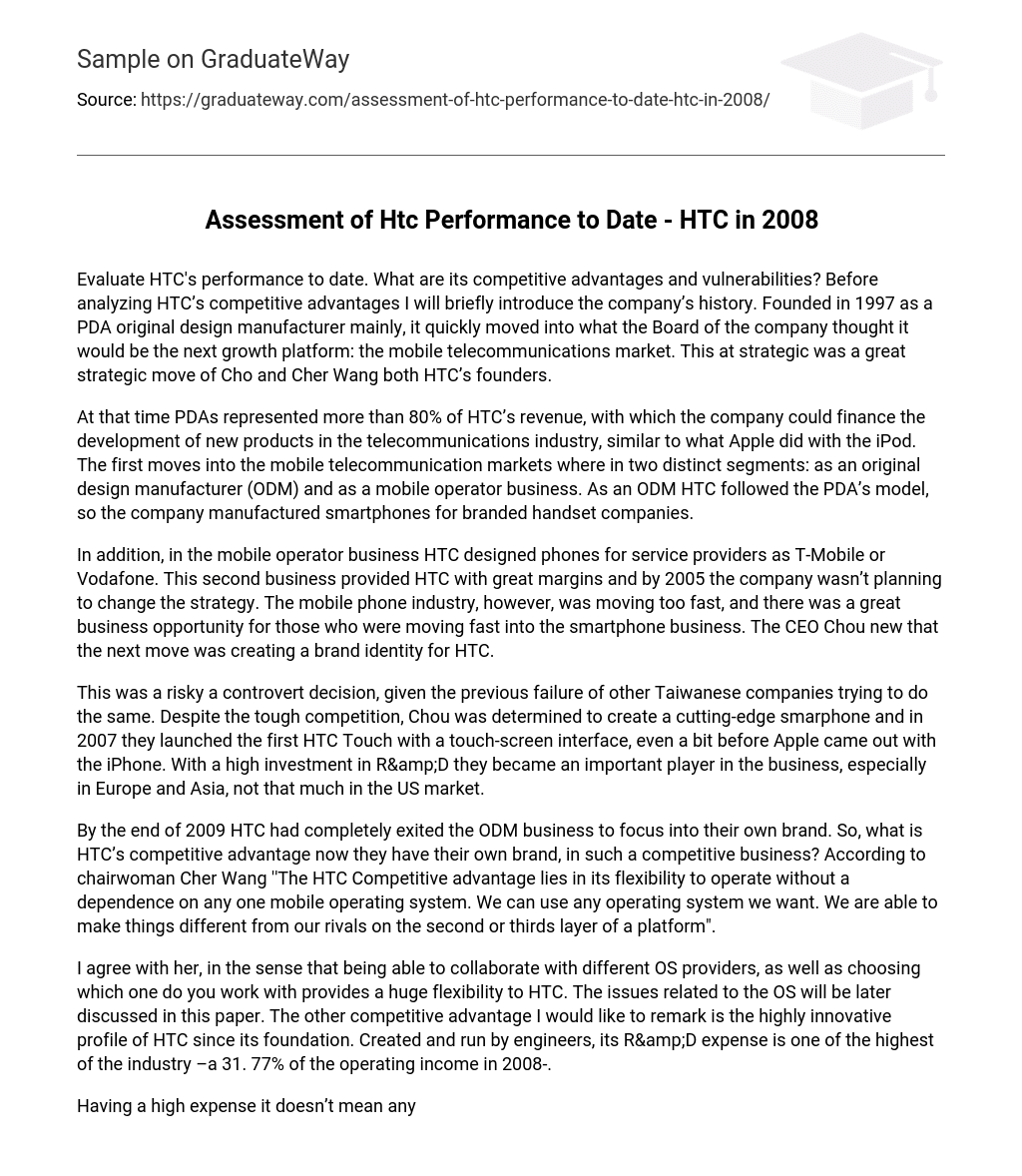Evaluate HTC’s performance to date. What are its competitive advantages and vulnerabilities? Before analyzing HTC’s competitive advantages I will briefly introduce the company’s history. Founded in 1997 as a PDA original design manufacturer mainly, it quickly moved into what the Board of the company thought it would be the next growth platform: the mobile telecommunications market. This at strategic was a great strategic move of Cho and Cher Wang both HTC’s founders.
At that time PDAs represented more than 80% of HTC’s revenue, with which the company could finance the development of new products in the telecommunications industry, similar to what Apple did with the iPod. The first moves into the mobile telecommunication markets where in two distinct segments: as an original design manufacturer (ODM) and as a mobile operator business. As an ODM HTC followed the PDA’s model, so the company manufactured smartphones for branded handset companies.
In addition, in the mobile operator business HTC designed phones for service providers as T-Mobile or Vodafone. This second business provided HTC with great margins and by 2005 the company wasn’t planning to change the strategy. The mobile phone industry, however, was moving too fast, and there was a great business opportunity for those who were moving fast into the smartphone business. The CEO Chou new that the next move was creating a brand identity for HTC.
This was a risky a controvert decision, given the previous failure of other Taiwanese companies trying to do the same. Despite the tough competition, Chou was determined to create a cutting-edge smarphone and in 2007 they launched the first HTC Touch with a touch-screen interface, even a bit before Apple came out with the iPhone. With a high investment in R&D they became an important player in the business, especially in Europe and Asia, not that much in the US market.
By the end of 2009 HTC had completely exited the ODM business to focus into their own brand. So, what is HTC’s competitive advantage now they have their own brand, in such a competitive business? According to chairwoman Cher Wang ”The HTC Competitive advantage lies in its flexibility to operate without a dependence on any one mobile operating system. We can use any operating system we want. We are able to make things different from our rivals on the second or thirds layer of a platform”.
I agree with her, in the sense that being able to collaborate with different OS providers, as well as choosing which one do you work with provides a huge flexibility to HTC. The issues related to the OS will be later discussed in this paper. The other competitive advantage I would like to remark is the highly innovative profile of HTC since its foundation. Created and run by engineers, its R&D expense is one of the highest of the industry –a 31. 77% of the operating income in 2008-.
Having a high expense it doesn’t mean anything by itself, but related to the high innovative product portfolio they offer it shows how important R&D is for HTC. However, HTC has to face great challenge. I would highlight 3 major vulnerabilities from HTC. The first on is related to being a relatively new company, created in 1997, and more specifically a new brand. Despite being well renowned as an ODM in the business, it was never presented to consumers before 2006. And having a brand name supposes huge marketing and sales expenses.
The second challenge HTC has to face, closely related to being a new brand, it’s its low market penetration in the US, one of biggest market for smartphones until today. According to the data provided in the case study in 2008 only a 2% of U. S. mobile phone users would choose HTC as first brand. This is clearly a disadvantage for HTC. Nevertheless, they are stronger in Asia, including China, a region where mobile shipments are expected to grow a lot in the next years specially compared to U. S. nd European market saturation. Finally, another weak spot for HTC is related to their cost structure. The company is trying to achieve greater economies of scale to be able to both lower the prices –and so expand their consume base- and increase their margins. To achieve this goal HTC could increase their market share. But as this is not easy to do, what HTC definitely has to do is increase the portion of common components across its portfolio, so they have a higher bargain power with their suppliers.





